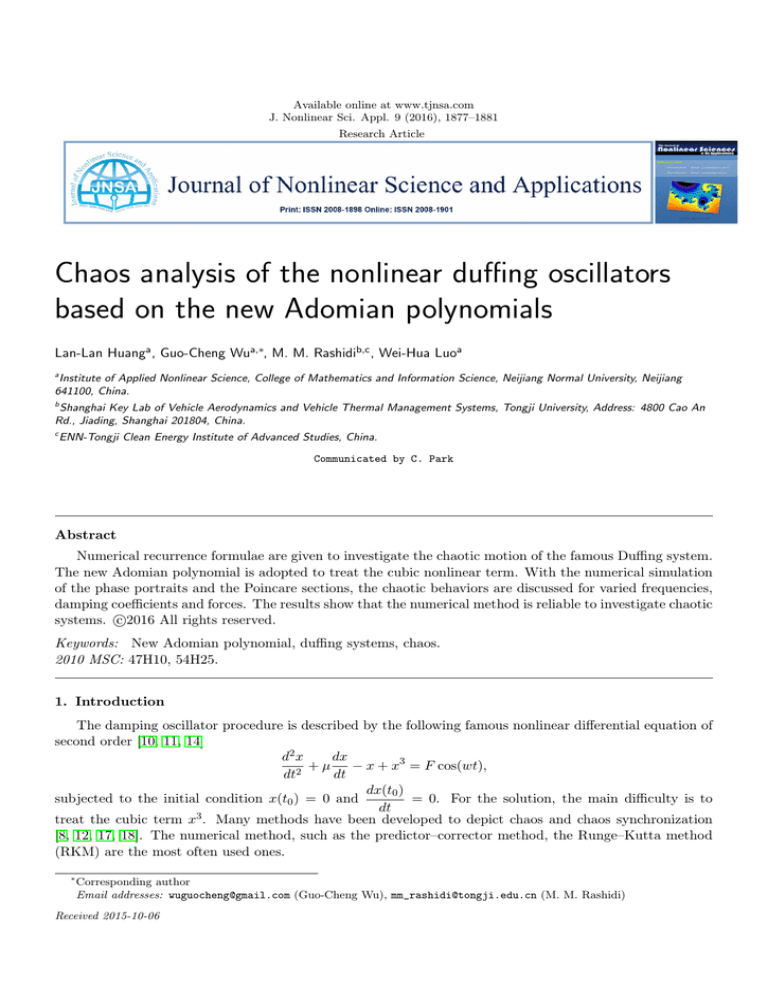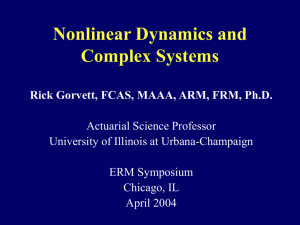
Available online at www.tjnsa.com
J. Nonlinear Sci. Appl. 9 (2016), 1877–1881
Research Article
Chaos analysis of the nonlinear duffing oscillators
based on the new Adomian polynomials
Lan-Lan Huanga , Guo-Cheng Wua,∗, M. M. Rashidib,c , Wei-Hua Luoa
a
Institute of Applied Nonlinear Science, College of Mathematics and Information Science, Neijiang Normal University, Neijiang
641100, China.
b
Shanghai Key Lab of Vehicle Aerodynamics and Vehicle Thermal Management Systems, Tongji University, Address: 4800 Cao An
Rd., Jiading, Shanghai 201804, China.
c
ENN-Tongji Clean Energy Institute of Advanced Studies, China.
Communicated by C. Park
Abstract
Numerical recurrence formulae are given to investigate the chaotic motion of the famous Duffing system.
The new Adomian polynomial is adopted to treat the cubic nonlinear term. With the numerical simulation
of the phase portraits and the Poincare sections, the chaotic behaviors are discussed for varied frequencies,
damping coefficients and forces. The results show that the numerical method is reliable to investigate chaotic
c
systems. 2016
All rights reserved.
Keywords: New Adomian polynomial, duffing systems, chaos.
2010 MSC: 47H10, 54H25.
1. Introduction
The damping oscillator procedure is described by the following famous nonlinear differential equation of
second order [10, 11, 14]
d2 x
dx
+µ
− x + x3 = F cos(wt),
dt2
dt
dx(t0 )
subjected to the initial condition x(t0 ) = 0 and
= 0. For the solution, the main difficulty is to
dt
3
treat the cubic term x . Many methods have been developed to depict chaos and chaos synchronization
[8, 12, 17, 18]. The numerical method, such as the predictor–corrector method, the Runge–Kutta method
(RKM) are the most often used ones.
∗
Corresponding author
Email addresses: wuguocheng@gmail.com (Guo-Cheng Wu), mm_rashidi@tongji.edu.cn (M. M. Rashidi)
Received 2015-10-06
L. L. Huang, G. C. Wu, M. M. Rashidi, W. H. Luo, J. Nonlinear Sci. Appl. 9 (2016), 1877–1881
1878
The famous Adomian decomposition method (ADM) was developed by Adomian in the last century [1].
Then, many modified versions have been proposed [1, 2, 9, 13, 15, 16, 19]. Very recently, Duan proposed a
new way to calculate Adomian polynomial and greatly improved the efficiencies for solutions [3, 4, 5, 6, 7].
The idea has been extended to solve the initial value problem of the fractional differential equations, two
point value problem of the differential ones. The efficiency and the accuracy are compared in [6]. The ADM
shows a perspective over the RKM. In view of this point, we adopt the new ADM so that we can better
describe the nonlinear dynamics of the oscillator.
In this paper, we use the idea of the ADM to depict the chaotic motion of the Duffing system and also
illustrate a general way to solve the initial value problem of differential equations of high order.
2. Basics
According to the theories of the ODEs, for a general differential equations of n-th order
dn x
dx
dn−1 x
+
F
(t,
x,
,
...
,
) = 0,
dtn
dt
dtn−1
we can have a differential system of first order so that the Duffing system [10] reads
dx
= y, x(t0 ) = 0.2,
dt
dy + µy − x + x3 = F cos(wt), y(t ) = 0,
0
dt
where µ is the damping coefficient, w is the frequency, x is the displacement and y is the velocity.
Much more generally, consider the differential equation of second order
d2 x
dx
dx(t0 )
+ F (t, x,
) = 0, x(t0 ) = a,
= b.
2
dt
dt
dt
We give the algorithm as the following.
dx
Step 1. Assume the transform
= y. One can obtain the following system
dt
dx
= y, x(t0 ) = a,
dt
dy + F (t, x, y) = 0, y(t ) = b.
0
dt
Step 2. Expand x(t) and y(t) in the form of the Taylor series
∞
X
x
=
ci,1 (t − t0 )i ,
i=0
∞
X
y
=
ci,2 (t − t0 )i .
i=0
Accordingly, the xn and the yn read
n
X
xn =
ci,1 (t − t0 )i ,
i=0
n
X
ci,2 (t − t0 )i .
yn =
i=0
Step 3. Following the idea in [6], one can derive a recurrence formula
1
cj,2 , c0,1 = a,
cj+1,1 =
j+1
−1
cj+1,2 =
F (t, cj,1 , cj,2 , Aj ), c0,2 = b, 0 ≤ j,
j+1
(2.1)
(2.2)
L. L. Huang, G. C. Wu, M. M. Rashidi, W. H. Luo, J. Nonlinear Sci. Appl. 9 (2016), 1877–1881
1879
which gives the solution Eq. (2.2). Here Aj is calculated by Duan [3, 4, 5, 6, 7]
j−1
Aj =
dAj−1−i
1X
.
(i + 1)ci+1,1
j
dc0,1
i=0
Step 4. Assume xn = ϕ1 (t, t0 , c0,1 , c0,2 ) and yn = ϕ2 (t, t0 , c0,1 , c0,2 ) which are the n-th order approximation. For t = t0 , we can have xn (t0 ) = c0,1 , yn (t0 ) = c0,2 . Once more, we choose t1 near t0 and xn (t1 ), yn (t1 )
as the initial values. As a result, we can successively obtain all the numerical solutions xn (ti ) and yn (ti ).
With the given length size and the node number to h and N , tn = t0 + nh, one can obtain the values
∗
x∗n = ϕ1 (tn , tn−1 , x∗n−1 ), yn∗ = ϕ1 (tn , tn−1 , yn−1
),
where the initial iteration reads
x∗0 = x(t0 ), y0∗ = y(t0 ).
3. Chaos Analysis
For Eq. (2.1), we can give the following numerical recurrence formula as
1
cj,2 , c0,1 = 0.2,
cj+1,1 =
j+1
−1
cj+1,2 =
(µcj,2 − cj,1 + Aj − fj ), c0,2 = 0, 0 ≤ j,
j+1
where fi is the coefficient and F cos(wt) =
n
P
fj (t − t0 )j .
j=0
Now we can discuss the chaotic motion with respect to t in Fig. 1a and Fig. 1b. Let j = 10, n =
2π
2000, h =
. The Poincare section and the phase trajectory are plotted in Fig. 2a and Fig. 2b from
100w
which one can determine the system’s chaotic state. Due to the sensitivity of the chaos, we can see minor
changes in the x(t0 ) and the y(t0 ) lead to great variations in the motion.
(a) Chaotic motion versus time t
(b) Chaotic velocity versus time t
Figure 1
Based on the numerical formulae, we also can consider the maximal x and y versus the variations of the
exciting force after t = 50 seconds. We can observe that in Figs. 3a and 3b, for F between 0.4 and 0.5, the
maximal x and y vary sharply.
L. L. Huang, G. C. Wu, M. M. Rashidi, W. H. Luo, J. Nonlinear Sci. Appl. 9 (2016), 1877–1881
(a) Poincare section
1880
(b) Phase trajectory
Figure 2
(a) Maximal displacement versus force
(b) Maximal velocity versus force
Figure 3
Here we only discuss the chaos behaviors of the Duffing system. For the error analysis, readers are
referred to [6].
4. Concluding remarks
This paper applies the new Adomian polynomial for the famous Duffing equation. The second order
equation is equivalently given as differential equations. Numerical recurrence formulae are given. Furthermore, the chaos including the phase trajectory and the Poincare sections are shown. The relationship
between the maximal displacement, the maximal velocity and variations of the force are discussed. We can
conclude that the new Adomian polynomial can be more easily used in the chaotic system and depict the
nonlinear dynamics more accurately than the classical one [1].
Acknowledgements
The work was financially supported by the Innovative Team Program of the Neijiang Normal University
(Grant No. 13TD02), the Seed Funds for Major Science and Technology Innovation Projects of Sichuan
Provincial Education Department (14CZ0026) and the National Natural Science Foundation of China (Grant
No. 11301257).
L. L. Huang, G. C. Wu, M. M. Rashidi, W. H. Luo, J. Nonlinear Sci. Appl. 9 (2016), 1877–1881
1881
References
[1] G. Adomian, Solving frontier problems of physics: the decomposition method, Kluwer Academic Publishers Group,
Dordrecht, (1994). 1, 4
[2] V. Daftardar–Gejji, H. Jafari, Adomian decomposition: a tool for solving a system of fractional differential
equations, J. Math. Anal. Appl., 301 (2005), 508–518. 1
[3] J. S. Duan, An efficient algorithm for the multivariable Adomian polynomials, Appl. Math. Comput., 217 (2010),
2456–2467. 1, 2
[4] J. S. Duan, Recurrence triangle for Adomian polynomials, Appl. Math. Comput., 216 (2010), 1235–1241. 1, 2
[5] J. S. Duan, Convenient analytic recurrence algorithms for the Adomian polynomials, Appl. Math. Comput., 217
(2011), 6337–6348. 1, 2
[6] J. S. Duan, R. Rach, New higher-order numerical one-step methods based on the Adomian and the modified
decomposition methods, Appl. Math. Comput., 218 (2011), 2810–2828. 1, 2, 3
[7] J. S. Duan, R. Rach, A new modification of the Adomian decomposition method for solving boundary value
problems for higher order nonlinear differential equations, Appl. Math. Comput., 218 (2011), 4090–4118. 1, 2
[8] G. Erjaee, Application of the multistage homotopy perturbation method to some dynamical systems, Iran. J. Sci.
Technol. Trans. A Sci., 35 (2011), 33–38. 1
[9] L. L. Huang, Transformation of series-A case of the exponent functions, J. Comput. Complex. Appl., 2 (2016),
44–45. 1
[10] S. W. Huang, T. Z. Zhen, Visualization based Analysis of Dynamic Property of Chaos in nonlinear forced vibration,
J. Hohai Univ. (Natural Science Edition), 30 (2002), 42–46. 1, 2
[11] I. Kovacic, M. J. Brennan, The Duffing equation: nonlinear oscillators and their behaviour, John Wiley & Sons,
Chichester, (2011). 1
[12] C. Li, G. Peng, Chaos in Chen’s system with a fractional order, Chaos Solitons Fractals, 22 (2004), 443–450. 1
[13] S. Momani, Z. Odibat, Analytical solution of a time-fractional Navier-Stokes equation by Adomian decomposition
method, Appl. Math. Comput., 177 (2006), 488–494. 1
2
[14] U. Parlitz, W. Lauterborn, Superstructure in the bifurcation set of the Duffing equation dx
+ dx
+ x + x3 =
dt
dt2
f cos(wt), Phys. Lett. A, 107 (1985), 351–355. 1
[15] P. Y. Tsai, C. K. Chen, An approximate analytic solution of the nonlinear Riccati differential equation, J. Franklin
Inst., 347 (2010), 1850–1862. 1
[16] A. M. Wazwaz, A reliable modification of Adomian decomposition method, Appl. Math. Comput., 102 (1999),
77–86. 1
[17] G. C. Wu, D. Baleanu, Discrete fractional logistic map and its chaos, Nonlinear Dynam., 75 (2014), 283–287. 1
[18] X. Wu, J. Li, G. Chen, Chaos in the fractional order unified system and its synchronization, J. Franklin Inst.,
345 (2008), 392–401. 1
[19] Y. Zeng, Approximate solutions of three integral equations by the new Adomian decomposition method, J. Comput.
Complex. Appl., 2 (2016), 38–43. 1







